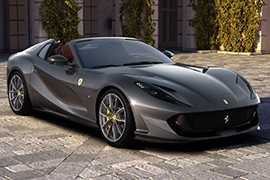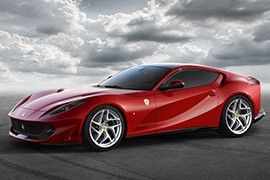FERRARI 812 Models/Series Timeline, Specifications & Photos
First production year: 2017
Engines: Gasoline
Body style: Coupé (two-door)
Two years after the introduction of its flagship model, the Gran Tourer 812 Superfast, Ferrari unveiled the open-top version of it, traditionally named GTS.
While the era of naturally aspirated engines was coming to an end, the Italian automaker released the 812 Superfast with its most powerful atmospheric production engines ever. But there was a problem with that. Its grand tourer was usually very well insulated from the exterior sounds, and that included the engine’s music.
So, the only way its customers could listen to it was to drive with their windows down. But when that was not good enough for them, the car manufacturer released the 812 GTS. Now, the recipe was complete and kept its customers happy.
The 812 Superfast followed the long lineage of high-performance vehicles made for long distances, such as the 365 GTB4 (Daytona), the 456, or the F12. As a result, it had the powerplant in front of the cabin but behind the front axle, meaning that it was a front-mid-engine vehicle. That resulted in a very long hood, where the automaker’s designers placed two discrete air-intakes next to the headlights. The entire front fascia was carried over from its coupe sibling, or Berlinetta, as Ferrari named that type of bodywork.
From its profile, there were the same vents behind the front wheel arches that extracted the air from inside the wheel wells. But from the waistline up, it was different. The power-retractable hard top could be concealed behind the cabin at the touch of a button, and the driver and their passenger sat exposed under the sky. Behind them, Ferrari placed two safety arches neatly concealed by two humps in the back.
For the two-seat cabin, Ferrari opted for expensive, luxurious materials such as leather, carbon fiber, and aluminum trims. In front of the driver was the same instrument cluster with a large rev counter that took center stage and was flanked by two TFT displays for additional data gathered from the vehicle’s onboard computer. Like in the 812 Superfast, there was a small screen in front of the passenger displaying the information for the audio system, the tachometer, the speedometer, and other data that they didn’t need but wanted to see.
The retractable hard top could be retracted in just 14 seconds at speeds of up to 45 kph (28 mph) at the flick of a switch. Finally, at the back, the automaker made additional changes to compensate for the lack of a fixed roof. As a result, there was a new diffuser underneath the bumper.
Under the hood was the same naturally aspirated 6.5-liter V12 that powered the 812 Superfast. The insane specific power of 123,14 PS/liter (121.45 hp/liter) was obtained at a stratospheric 8,500 rpm. All the power was sent to the rear wheels via a seven-speed automatic (dual-clutch) gearbox via an electronically-controlled limited-slip differential.
Most of the Ferrari in history had a specific appeal, and they were significant for their times, but when it introduced a flagship model, it was a stunning appearance such as the 2017 812 Superfast.
Ferrari always was a symbol of power, performance, beauty, and speed, and the 812 was all of that. It was premiered at the 2017 Geneva Motor Show, and it was the fastest, quickest, and most potent in the Ferrari's 70 years history. It goes without saying that it was packed with race-inspired technologies.
The Ferrari Styling Center, led by Flavio Manzoni, designed the lines of the 812. At the front, the design team incorporated air-intakes next to the LED-headlights, and the V-shapes over the hood diverted the air around the cabin. On the sides, the air escaped through the air-vents behind the front wheels flow toward the rear over sculptured door panels, diverted over the rear shoulders. Manzoni took its inspiration from past glorious models such as the 1969 365 GTB for the back's high tail. In the rear, the four-round taillights were already traditional for the Italian brand.
Inside, the car featured a pair of sport bucket seats with high bolstering on the sides. The dashboard was curved and clean, without any big-screen infotainment systems. Like the F12 TDF before, there was a small screen in front of the passenger displaying the information for the audio system. The instrument cluster featured a big, center tachometer with a yellow dial and a red needle and two side TFT screens for other onboard computer data.
Under the hood, Ferrari installed a naturally aspirated V12 engine that provided 800 hp at 8.500 rpm. It was mated to a seven-speed automatic (dual-clutch) gearbox.

